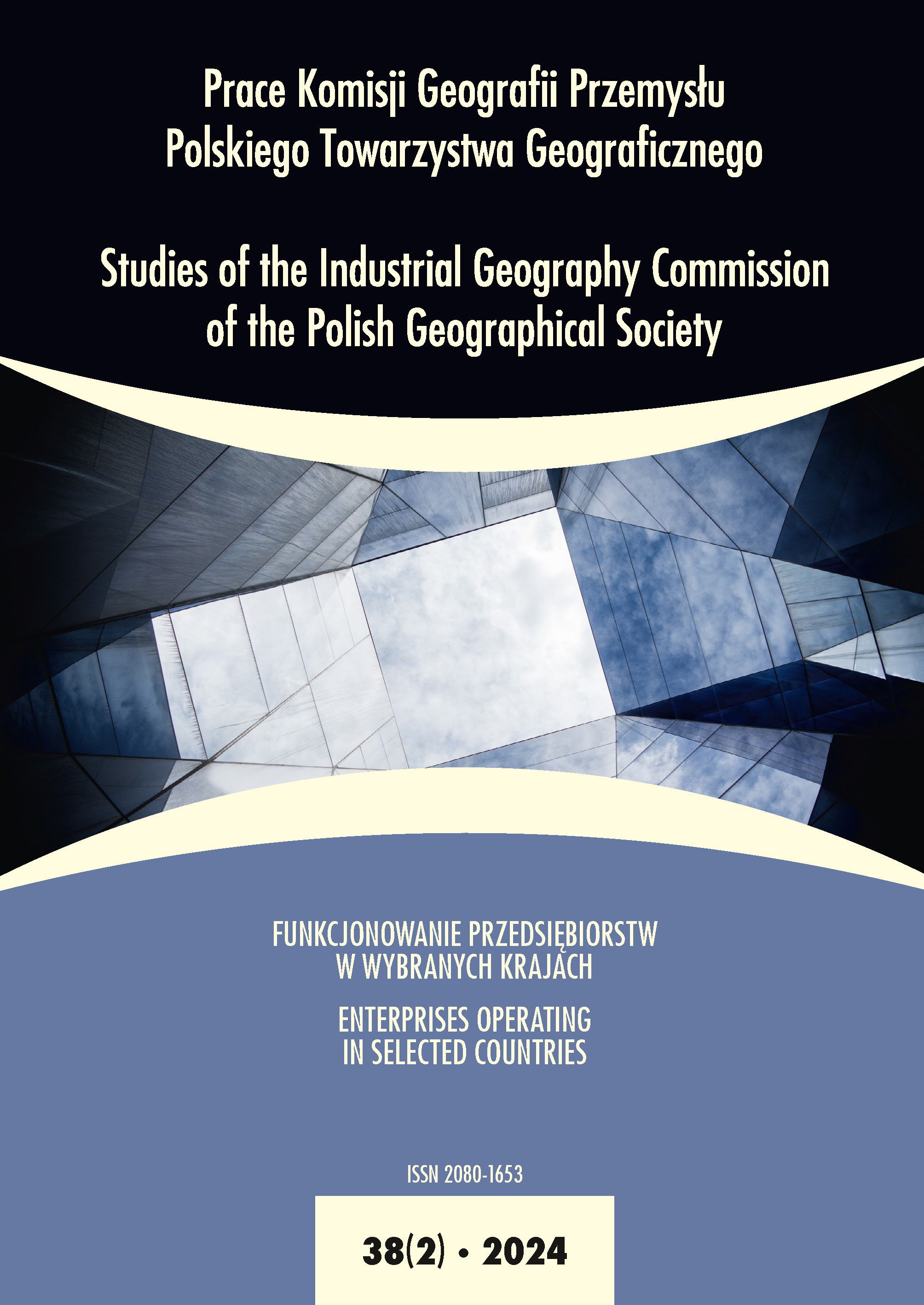Modelling the impact of manufacturability and import dependence on the efficiency of the processing industry of Ukraine
DOI:
https://doi.org/10.24917/20801653.382.3Słowa kluczowe:
efficiency, gross value added (GVA), import dependence, industry, intermediate consumption, manufacturability, production optimisationAbstrakt
The article aims to model the processing industry of Ukraine in the direction of increasing its economic efficiency according to the criteria of manufacturability and self-sufficiency (i.e. reducing import dependence). The regularities of the impact of technology and import dependence on the functional efficiency of the economy’s industrial sector are revealed. The authors’ hypothesis that higher economic efficiency in processing is explained by its greater focus on high-tech processes and production with a greater degree of the processing of raw materials, as well as a lower level of dependence on imported components, has been empirically proven. With the help of correlation-regression analysis, dependence between change in structural parameters (the share of high- and medium-high-tech industries in terms of output and the share of imports for intermediate consumption) and efficiency (the share of GVA in output) is substantiated. Deterministic economic-mathematical models (solved by linear programming) for optimising output and GVA in the processing industry and intermediate consumption were built according to the criteria of increasing manufacturability and reducing import dependence, both towards increasing efficiency. Such intermediate consumption (in terms of imported and domestic components of costs) was modelled, under which the indicator of the share of GVA of Ukraine would correspond to the level in Poland. The optimised data obtained form the basis for strategic planning, as they show what the output (by manufacturability) and intermediate consumption should be to ensure the desired level of economic efficiency of the Ukrainian processing industry.
Downloads
Metrics
Bibliografia
Amosha, O.I., Bulyeyev, I.P., Zemlyankin, A.I., Zbarazska, L.O., Kharazishvili, Yu. M. et al. (2017). Industry of Ukraine 2016: The state and prospects of development. Retrieved from: http://iep.com.ua/publ/informacijni_resursi/naukovi_dopovidi/promislovist_ukrajini2016_stan_ta_perspektivi_rozvitku/2-1-0-95 [in Ukrainian], (accessed: 10.01.2024).
Eurostat. (2023). Official website of Eurostat. Retrieved from: https://appsso.eurostat.ec.europa.eu/ (accessed: 10.01.2024).
Heyets, V.M., Ostashko, T.O. (eds.) (2016). The implementation of the Agreement about Association between Ukraine and the EU: Economic Challenges and opportunities. Kyiv: Institute for Economics and Forecasting NAS of Ukraine [in Ukrainian].
Ishchuk, S., Sozanskyy, L. (2022). National Mechanical Engineering in Conditions of Economic Globalization. Management and Production Engineering Review, 13, 4, 107–125. doi: https://doi.org/10.24425/mper.2022.142399/
Ishchuk, S., Sozanskyy, L., Caputa, W. (2023). The impact of innovation onemployment and earnings in Ukrainian industry. Prace Komisji Geografii Przemysłu Polskiego Towarzystwa Geograficznego [Studies of the Industrial Geography Commission of the Polish Geographical Society], 37(4), 26–40. doi: https://doi.org/10.24917/20801653.374.2
Ishchuk, S., Sozanskyy, L., Kniaziev, S. (2023). Problematic issues of localisation-based development of mechanical engineering in Ukraine. Science and Innovation, 19(1), 20–35. doi: https://doi.org/10.15407/scine19.01.020
Ishchuk, S., Sozanskyy, L., Pukała, R. (2020). Optimisation of the relationship between structural parameters of the processing industry as a way to increase its efficiency. Engineering Management in Production and Services, 12(2), 7–20. doi: https://doi.org/10.2478/emj2020-0008
Okhtenj, O.O. (2013). Bazovyj scenarij dovghostrokovogho rozvytku nacionaljnoji promyslovosti do 2035 roku [The basic scenario of the long-term development of the national industry until 2035]. Ekonomika promyslovosti – Industrial Economics, 1(101). Retrieved from: http://ojs.econindustry.org/index.php/ep/article/view/270/327 [in Ukrainian], (access: 10.01.2024).
Shynkaruk, L.V., Bevz, I.A., Baranovska, I.V. et al. (2015). The structural transformations in the economy of Ukraine: dynamics, contradictions and impact on economic development. Kyiv: Institute for Economics and Forecasting NAS of Ukraine [in Ukrainian].
Soldak, M.O. (2022). Systema vyperedzhaljnykh indykatoriv rozvytku nacionaljnoji promyslovosti: konceptualjnyj pidkhid [The system of anticipatory indicators of the development of national industry: a conceptual approach]. Ekonomika promyslovosti – Industrial Economics, 3(99). Retrieved from: http://ojs.econindustry.org/index.php/ep/article/view/254/308 [in Ukrainian], (access: 10.01.2024).
SSSU. (2023). State Statistics Service of Ukraine. Retrieved from: https://ukrstat.gov.ua/ (access: 10.01.2024).
Vyshnevskyj, V.P., Zbarazska, L.O., Polovyan, O.V., Zanizdra, M. Yu., Chekina, V.D. et al. (2016). National model of neoindustrial development. Retrieved from: http://iep.com.ua/Vishnevskiy_Zbarazska_Zanizdra_Chekina_2016.pdf [in Ukrainian], (access: 10.01.2024).
Zbarazsjka, L.O. (2022). Promyslovistj Ukrajiny u svitovomu «landshafti»: tendenciji v konteksti zavdanj dovghostrokovogho rozvytku [Ukrainian industry in the world «landscape»: trends in the context of long-term development tasks]. Ekonomika promyslovosti – Industrial Economics, 2(98). Retrieved from: http://ojs.econindustry.org/index.php/ep/article/view/245/299 [in Ukrainian], (access: 10.01.2024).
Pobrania
Opublikowane
Jak cytować
Numer
Dział
Licencja
Prawa autorskie (c) 2024 Prace Komisji Geografii Przemysłu Polskiego Towarzystwa Geograficznego

Utwór dostępny jest na licencji Creative Commons Uznanie autorstwa – Bez utworów zależnych 4.0 Międzynarodowe.
Artykuły publikowane są zgodnie z warunkami licencji Creative Commons (CC BY-ND 4.0; uznanie autorstwa-bez utworów zależnych).

